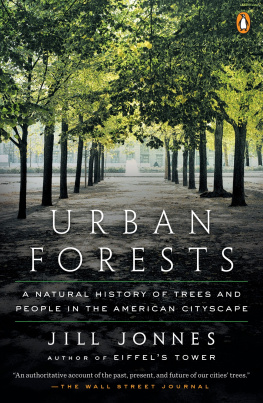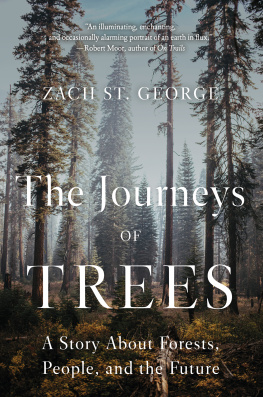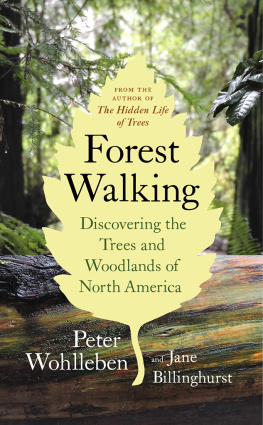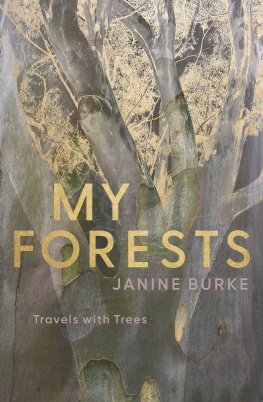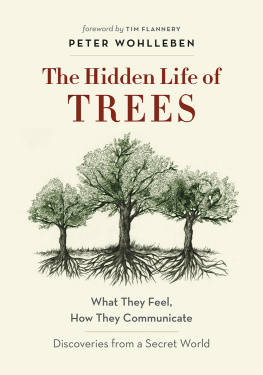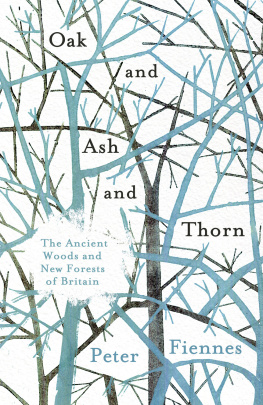C. Watkins - Trees, woods and forests : a social and cultural history
Here you can read online C. Watkins - Trees, woods and forests : a social and cultural history full text of the book (entire story) in english for free. Download pdf and epub, get meaning, cover and reviews about this ebook. year: 2016, genre: Romance novel. Description of the work, (preface) as well as reviews are available. Best literature library LitArk.com created for fans of good reading and offers a wide selection of genres:
Romance novel
Science fiction
Adventure
Detective
Science
History
Home and family
Prose
Art
Politics
Computer
Non-fiction
Religion
Business
Children
Humor
Choose a favorite category and find really read worthwhile books. Enjoy immersion in the world of imagination, feel the emotions of the characters or learn something new for yourself, make an fascinating discovery.
- Book:Trees, woods and forests : a social and cultural history
- Author:
- Genre:
- Year:2016
- Rating:5 / 5
- Favourites:Add to favourites
- Your mark:
- 100
- 1
- 2
- 3
- 4
- 5
Trees, woods and forests : a social and cultural history: summary, description and annotation
We offer to read an annotation, description, summary or preface (depends on what the author of the book "Trees, woods and forests : a social and cultural history" wrote himself). If you haven't found the necessary information about the book — write in the comments, we will try to find it.
C. Watkins: author's other books
Who wrote Trees, woods and forests : a social and cultural history? Find out the surname, the name of the author of the book and a list of all author's works by series.
Trees, woods and forests : a social and cultural history — read online for free the complete book (whole text) full work
Below is the text of the book, divided by pages. System saving the place of the last page read, allows you to conveniently read the book "Trees, woods and forests : a social and cultural history" online for free, without having to search again every time where you left off. Put a bookmark, and you can go to the page where you finished reading at any time.
Font size:
Interval:
Bookmark:

TREES, WOODS AND FORESTS

Trees, Woods
and Forests
A Social and Cultural History

Charles Watkins
REAKTION BOOKS
Published by Reaktion Books Ltd
33 Great Sutton Street
London EC1V 0DX, UK
www.reaktionbooks.co.uk
First published 2014
Copyright Charles Watkins 2014
All rights reserved
No part of this publication may be reproduced, stored in a retrieval system, or transmitted, in any form or by any means, electronic, mechanical, photocopying, recording or otherwise, without the prior permission of the publishers
Page references in the Photo Acknowledgments and
Index match the printed edition of this book.
Printed and bound in Great Britain
by TJ International, Padstow, Cornwall
A catalogue record for this book is available from the British Library
eISBN: 9781780234151
 CONTENTS
CONTENTS
But when I walk past our village woodlands which Ive saved from the axe or hear the rustle of my own saplings, planted with my own hands, I feel I too have some control over the climate and that if man is happy a thousand years from now Ill have done a bit towards it myself.
Dr Astrov in Anton Chekhov, Uncle Vanya, Act I (1897), trans. Ronald Hingley
The ash is quite bare. Oddly enough the last leaves seem to linger on the top rather than lower down, as one might have expected. Its really shocking, I am becoming a nature-lover and observer fatal! The intellect fades in proportion.
Lytton Strachey to Roger Senhouse, 12 November 1928
What kinds of times are they, when A talk about trees is almost a crime Because it implies silence about so many horrors?
Bertolt Brecht, To Those Born Later, c. 1938
 Introduction
Introduction
O UR understanding of the history of trees and woodlands has been transformed in recent years. Established ideas, such as the spread of continuous dense forests across the whole of Europe after the Ice Age, have been questioned, if not overturned, by archaeological and historical research. While there is continued clearance of tropical forests, concern over woodland loss in Europe, where the area of land covered by trees has increased substantially in the last century, is less well founded. Recent research shows that the interactions between humans and trees and woods have varied dramatically through time and from place to place. Over history the clearance of woodland has often been celebrated as a sign of increasing population; an indication of improved agricultural production; a surrogate for civilization. But woodland is not a simple category from which a settled landscape has been wrought. Rather it is a complex category which has varied dramatically in the density, age, species and form of its trees and shrubs. The utility of woodland and the cultural values ascribed to it are also diverse, whether it is tilled or grazed by domestic stock: it may be a provider of status or symbolic power, a site of traditional management or scientific experimentation.
A key issue is that the same trees and woods are perceived very differently by different people at the same time, and by groups of people through time. John Ruskin argued that a love of trees could be a moral test failed by those who disliked them, but most people like trees in some circumstances and dislike them in others. And the reasons for like or dislike can sometimes be almost unfathomable due to personal recollections and associations with trees. I vividly remember being shown in 1978, from a library window, an attractive nineteenth-century landscape park in the English Midlands scattered into the distance with a diverse range of plantations and groves. While I was appreciating the well-tended young plantations of pine and the old oaks, the owner pointed out with relish that the plantation to the left was under Schedule D for income tax purposes and the clumps of oaks to the right were Schedule B, while the large wood in the middle distance was a mixture of both. The view was revealed as a landscape of tax avoidance. The principal reason the woods were so carefully tended was that the movement of woods between schedules allowed heavy expenditure incurred during replanting to be offset against income from other sources. The beauty and productivity of the woodland was a consequence of the then tax regime, which had been introduced in 1915 to encourage woodland management. This meaning was invisible to anyone uninitiated into the intricacies of tax accounting.
The aim of this book is to examine how different understandings and values ascribed to trees, woods and forests help to provide rich layers of association and meaning to them. The pattern of trees in the landscape is the result of centuries of unremitting hard work by our ancestors as they struggled to survive in harsh conditions. The work of management and control of trees has involved careful shepherding of flocks of sheep and goats, manipulation of fire and skilled harvesting of leaves, fruits, seeds and branches. Woodland can be benign and provide shelter, warmth, sustenance, fuel and fodder. But it may also be dark, disorientating and threatening and associated with debauchery and death. The landscape of woods and forests is imprinted with ancient patterns of power and desire.
This book explores our understanding and knowledge of trees, woods and forests by examining a series of episodes and moments in woodland history. It draws on a wide array of sources and approaches. The history of trees and woods is intrinsically interdisciplinary; research is carried out by archaeologists, botanists, ecologists, foresters, geographers and historians. Much of the most interesting and fruitful research is being undertaken at the edge of disciplines and uses approaches from cultural history, historical ecology, local history, natural history, historical geography and field ecology. Very different forms of evidence are combined to develop an understanding of the history and development of a particular piece of vegetation. This evidence may include surveys of present-day plants and animals; historical maps and documents; field archaeology; dendrochronology; oral history; land management practices; literary descriptions; genetic analysis; pollen and soil analysis; aerial photographs; and drawings and paintings.
The shape and form of a tree is itself one of the best sources of evidence of its history. It can tell you whether a tree has been lopped or coppiced in the past and whether it has been affected by diseases, grazing or browsing. Trees are usually defined as having some sort of perennial, woody growth which often, but not always, has a main stem or trunk with woody branches. They are enormously varied: some species, such as the Californian coast redwood (Sequoia sempervirens), can grow over 100 metres high and form dense stands of ancient trees. By contrast, the alpine woods of the Hayachine mountain in northern Honshu consist of 1- to 2-metre-high species such as Pinus pumila and Tsuga diversifolia hugging the ground in dense low mats of interlocking vegetation where it is difficult to distinguish individual trees ().
The ideas associated with the terms woods and forests vary through time and from country to country. Recent research in historical ecology is increasingly showing that the boundaries between woodland, wood pasture, pasture with trees and arable land are difficult to define with precision. In general terms, distinct boundaries between dense woodland and more open woodland have become more pronounced in many places over the last 300 years. These changes are related to the more intensive management of land and the greater control over grazing, and are very closely tied to changes in the pattern of land ownership and control. But there remain many areas of semi-natural vegetation where it is difficult to map distinct boundaries between woodland and non-woodland.
Font size:
Interval:
Bookmark:
Similar books «Trees, woods and forests : a social and cultural history»
Look at similar books to Trees, woods and forests : a social and cultural history. We have selected literature similar in name and meaning in the hope of providing readers with more options to find new, interesting, not yet read works.
Discussion, reviews of the book Trees, woods and forests : a social and cultural history and just readers' own opinions. Leave your comments, write what you think about the work, its meaning or the main characters. Specify what exactly you liked and what you didn't like, and why you think so.




